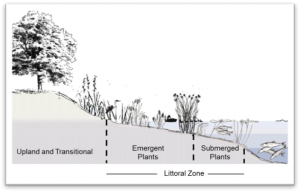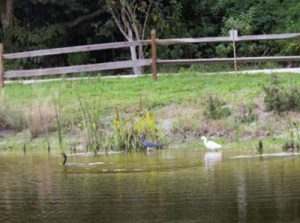You Can Help Improve Water Quality on Sanibel
(Author’s Note: This article is a joint effort between the City of Sanibel Natural Resources Department and the Sanibel Vegetation Committee. It is the seventh in a series of articles dealing with vegetative matters of concern to island residents. Members of the Vegetation Committee are Sanibel residents appointed by City Council for one-year terms. To be considered for appointment, contact the City Manager’s Office at (239) 472-3700.)
If you own property adjacent to one of Sanibel’s many lakes, wetlands or waterways, you can help protect and/or improve water quality within your community. Homeowner’s associations are also in a unique position to facilitate changes that can enhance water quality by embracing Best Management Practices (BMPs) aimed at reducing stormwater runoff entering community lakes. One cost-effective practice that improves water quality and provides a number of other important ecological benefits is the planting and maintenance of the shoreline littoral zone.
What is the littoral zone?
 The littoral zone is the shallow area along the edge of a waterbody where sunlight penetrates all the way to the sediment, allowing aquatic plants to grow.
The littoral zone is the shallow area along the edge of a waterbody where sunlight penetrates all the way to the sediment, allowing aquatic plants to grow.
Why is maintaining vegetation within the littoral zone important?
Littoral zone vegetation can provide a number of important ecosystem services including buffering of stormwater runoff that contains nutrients such as nitrogen and phosphorus or other pollutants, shoreline protection and stabilization, food and habitat for wildlife, and a seed source for other areas. Littoral zone plantings can also provide important economic benefits such as improving neighborhood aesthetics and increasing property values.
How does littoral zone vegetation improve water quality in my community lake?
Shoreline plantings provide an important buffer between upland landscapes and waterbodies by taking up excess phosphorus and nitrogen originating from fertilizers, pet waste, and vegetative debris, as well as other pollutants carried by stormwater runoff. This reduces the amount of nutrients available to algae and other nuisance aquatic vegetation, resulting in a cleaner and clearer community lake.
- BEFORE

(Photo: Courtesy of City of Sanibel) - AFTER

(Photo: Courtesy of City of Sanibel)
How does littoral zone vegetation protect and stabilize my shoreline?
Shoreline vegetation has a complex network of roots that help stabilize sediments and hold lake banks together preventing erosion. These plants also slow down the flow of stormwater runoff, attenuate wave action, and trap sediments that would otherwise flow directly into the waterbody. This helps prevent shoreline erosion and silting-in of lakes or other waterbodies.
How does the littoral zone provide food and habitat for wildlife?

(Photo: Courtesy of Ruth Brooks, Vegetation Committee Member)
Native plants planted in the appropriate location and within suitable conditions (i.e., proper salinity range and water depth) provide foraging opportunities for waterfowl, marsh birds, wading birds, alligators, turtles, fishes, among others. These plantings also provide important structure and cover for invertebrates and fishes that form the basis of the aquatic food web and nesting sites for secretive marsh birds and waterfowl. A vegetated tree-lined shoreline may provide shade that helps keep water temperatures lower, resulting in a better natural habitat for many native species.
What other benefits do littoral zone plantings provide?
Provide a Seed Source
- Littoral plantings provide a seed source for a healthy expansion into other waterbodies and wetland areas.
May Act as an Alligator Deterrent
- Vegetated shorelines can be utilized to discourage alligators from basking in neighborhood yards. Since alligators use the sun to help regulate their body temperature, a shady well-vegetated shoreline discourages alligators from basking. For more information about landscaping for alligators contact the Sanibel-Captiva Conservation Foundation at 472-2329.
Improves Aesthetics and Property Values
- A carefully planned and maintained littoral zone can enhance the beauty and value of your property. Shoreline vegetation can mask seasonal changes in lake water levels and unsightly water debris, such as algae that may appear periodically. Strategically placed vegetation along your shoreline can also help frame in that picturesque water view that you moved to Sanibel to enjoy.
If you are considering transforming your lifeless shoreline into a vibrant living filter to improve our island’s water quality, you will want to consider the following steps:
- Determine who owns and manages the shoreline of the waterbody you are planning to enhance or restore. Identify any HOA restrictions or City Codes that may apply. For help, please contact your neighborhood HOA or the City of Sanibel Planning Department at 472-4136
- Develop a planting plan using native plants suitable for your specific location taking into consideration existing and future environmental conditions. Consider seasonal water levels and salinity fluctuations in your planting plan and how they may affect which plants you can use in your project. Evaluate existing native plants that can be incorporated into the planting plan and identify exotic plants that may need to be removed. For help choosing native plants or for a review of your plan, please contact the City of Sanibel Natural Resources Department at 472-3700.
- After all this is complete, you are now ready to start planting.*If you do not have a suitable littoral zone for planting you may need to consider further shoreline restoration options. Please consult with the City’s Natural Resources and Planning departments for options and permit requirements.
Other things to keep in mind…..
- Fertilizer is prohibited within 25 feet of any waterbody or wetland.
- Always keep safety in mind when planting and maintaining the littoral area. Alligators can be found in any waterbody on Sanibel.
- All herbicides must be applied by a state licensed contractor. Always follow product labels carefully. The label is the law!
- Dispose of pet waste responsibly, this waste not only carries viruses and bacteria, but also contributes nutrients to the waterbody.
- Any lawn cuttings or leaves should be directed away from the water body.
If you are not planning to do the work yourself, be sure your vegetation contractor has a valid “Vegetation Competency Card” and is licensed through the City of Sanibel. For more information on approved vegetation contractors and local nurseries, please contact the City of Sanibel’s Natural Resource Department at 472-3700.

 Share on Facebook
Share on Facebook Share on Twitter
Share on Twitter